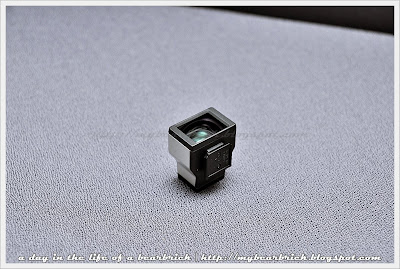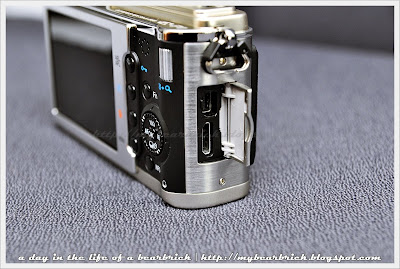
OLYMPUS E-P1
"with this i pen my life"
When the first digital version from Olympus's PEN legacy, PEN E-P1 was launched in 2009, it is the first compact mirrorless interchangeable lens camera. The E-P1 was immediately well received by photography industry, which subsequently initiated the need for other camera makers follow suit. Panasonic, which shares the same micro-4/3 mount, released the GF-1. Such mirrorless interchangeable lens camera was really dominated by the PEN and Lumix GF-1, until Sony announced their NEX series, NEX-3 and NEX-5. By then, Olympus has released their revision of E-P1, the E-P2 and E-PL1. The koreans also released their own, Samsung NX-100. Now it really leaves Nikon, Canon and Pentax out of the picture.
In 2009, I already had my eyes on it for its retro-chic rangefinder look and solid stainless steel construction. At that time, I really did not have the justification to make sure I get my hands on one (I never had reasons when it comes to splurging on cameras anyway). Hence, I decided to score the PEN E-P1 in 2010. I did not blog and talk much about it. I got it in a spur of a retail therapy, simply because the deal was irresistable then. I scored the E-P1 at S$1299 which includes the E-P1, VF-1 viewfinder, M. Zuiko 14-42mm F3.5-5.6 lens, 17mm F2.8 Pancake lens, FL-14 external hotshoe flash, 2 original batteries, tripod, case and 2x 8GB SDHC cards. At that time, I could have forked out another S$200 to get the improved E-P2 with single lens only. But I really did not see the need to pay extra for the mild improvements.
The PEN E-P1 then became my trusted companion when I go around wanting more than my LUMIX LX3 and less the weight of my Nikons.
NEW BLOG FEATURE!
CLICK ON IMAGES TO ZOOM IN!



VF-1 external optical viewfinder
This is really useful only with the pancake lens.


M. Zuiko 14-42mm F3.5-5.6 lens
The kit lens with a 3x zoom. The kit lens can be collapsed into a small cylinder when not in use.




17mm F2.8 Pancake lens
The pancake lens is super compact and really ideal for walkabout. The fast f/2.8 captures creamy bokeh and extremely sharp images.


The twin lens kit.

E-P1 comes in a solid stainless steel construction that can withstand knocks and even drop.




E-P1 In a nutshell
12.3 Megapixel Live MOS Sensor
TruePic V image processor
3.0" LCD screen (fixed, 230k dot resolution)
HD movies (720p) with stereo sound
3.0 fps burst rate
Built-in IS with up to 4-EV steps efficiency
Dual control dials
Face Detection & Shadow Adjustment
Art Filters, multi-aspect ratios, multi exposure, scenes
In-camera raw conversion (including application of Art Filters)
Optional adaptors to use standard 4/3 lenses





E-P1 Up Close
The PEN E-P1 does not come with a built-in flash, since it they are rather useless for serious photographers. The hotshoe accessory allows the use of an external flash unit, such as the FL-14. I have tried and it does trigger off my Nikon SB-600 Speedlight.
 The black PEN E-P1 on the top left-hand corner is meant for mode selection.
The black PEN E-P1 on the top left-hand corner is meant for mode selection.
The chrome dial on the top right-hand corner can be programmed to control exposure compensation, aperture or shutter speed. The ring dial on the rear is somewhat similar to that on higher end Canon DSLRs. This dial can be programmed to control exposure settings as well. The ring dial sits on the circumference of a 4-directional cursor.



Lens release catch.

USB and mini-HDMI output ports.

On top of the one battery included, my deal came with an additional Original battery.

FL-14 External Flash for PEN E-P1
The deal which I got, came with the basic hotshoe flash. Better than nothing. It runs on 2x AA cells.




It took me almost a year after getting the PEN E-P1, to write about it. Seriously, it does not deserve such back-dated attention! The only reason is that I was so busy using it, such that I had no chance to give it a decent shoot. These images were taken ad-hoc when I first got it. Since then, I never got down to touching 'em up.
When I scored the PEN E-P1, it was really an excellent deal since the store was trying to clear their backlogs, especially with E-P2 and E-PL1 on the shelves.
So why not the improved E-P2 or the cheaper E-PL1?
When E-P1 was released, E-P1 was soon identified to be plagued by a serious problem, auto-focusing. The AF on the E-P1 was developed such that it will always "scan" the entire focus range before locking. This made the E-P1 come under scrutiny for having a slow AF. However, even with firmware release, the issue was not solved entirely with only slight improvements. After confirming it myself, I felt that it was really acceptable for most situations. When Panasonic released its GF-1, it came with an accessory port under its hotshoe. This port is meant for the use of accessories such as external electronic viewfinder (EVF) or microphone. Olympus then quickly released the E-P2 to include this accessory port as well. In short, E-P2 was not really a paramount improvement from E-P1. E-PL1 is essentially the E-P2 built on plastic and less professional controls, thus commanding a budget price tag. Hence, I felt that getting the E-P1 was really a steal, not in terms of price reduction, but all the useful accessories that was thrown into the deal.
So far, I am still very much happy with the performance of the PEN E-P1. It had followed me overseas and many occasions in low-light. The noise control is excellent and the colours are rich! The sharpness is brilliant on the pancake wide-open and on the kit lens when stopped down. Image stabilization is rather decent, giving steady and sharp images right down to 1/8s. In combination with the excellent noise control, the E-P1 is a real low-light performer! Despite the lack-lustre AF performance, it is really quite manageable in situations when you have the luxury of time to focus and frame. The solid construction is a gem! When I first tried out the demo in the store from chest height on non-carpeted floor. There was only a mild scratch! Such construction deserves the thumbs up! You won't get that on the E-PL1. Apart from its retro-chic rangefinder appearance that is very sought after, the E-P1 being the pioneer of compact mirrorless interchangeable lens digital camera, is the reason I chose to get it. Of course, I got a damn good deal back then!
During my trip to Japan, I also realized that the PEN is extremely popular among the youth and has created a culture of itself. Mooks were made under the name of PEN. Basically, it is all about penning your stories with pictures from the PEN. Hence, it inspired to get the PEN as well.
"with this I pen my life" begins here!
When I scored the PEN E-P1, it was really an excellent deal since the store was trying to clear their backlogs, especially with E-P2 and E-PL1 on the shelves.
So why not the improved E-P2 or the cheaper E-PL1?
When E-P1 was released, E-P1 was soon identified to be plagued by a serious problem, auto-focusing. The AF on the E-P1 was developed such that it will always "scan" the entire focus range before locking. This made the E-P1 come under scrutiny for having a slow AF. However, even with firmware release, the issue was not solved entirely with only slight improvements. After confirming it myself, I felt that it was really acceptable for most situations. When Panasonic released its GF-1, it came with an accessory port under its hotshoe. This port is meant for the use of accessories such as external electronic viewfinder (EVF) or microphone. Olympus then quickly released the E-P2 to include this accessory port as well. In short, E-P2 was not really a paramount improvement from E-P1. E-PL1 is essentially the E-P2 built on plastic and less professional controls, thus commanding a budget price tag. Hence, I felt that getting the E-P1 was really a steal, not in terms of price reduction, but all the useful accessories that was thrown into the deal.
So far, I am still very much happy with the performance of the PEN E-P1. It had followed me overseas and many occasions in low-light. The noise control is excellent and the colours are rich! The sharpness is brilliant on the pancake wide-open and on the kit lens when stopped down. Image stabilization is rather decent, giving steady and sharp images right down to 1/8s. In combination with the excellent noise control, the E-P1 is a real low-light performer! Despite the lack-lustre AF performance, it is really quite manageable in situations when you have the luxury of time to focus and frame. The solid construction is a gem! When I first tried out the demo in the store from chest height on non-carpeted floor. There was only a mild scratch! Such construction deserves the thumbs up! You won't get that on the E-PL1. Apart from its retro-chic rangefinder appearance that is very sought after, the E-P1 being the pioneer of compact mirrorless interchangeable lens digital camera, is the reason I chose to get it. Of course, I got a damn good deal back then!
During my trip to Japan, I also realized that the PEN is extremely popular among the youth and has created a culture of itself. Mooks were made under the name of PEN. Basically, it is all about penning your stories with pictures from the PEN. Hence, it inspired to get the PEN as well.
"with this I pen my life" begins here!
Some sample images from the PEN E-P1







See OLYMPUS PEN E-P1 Special Site
Comments